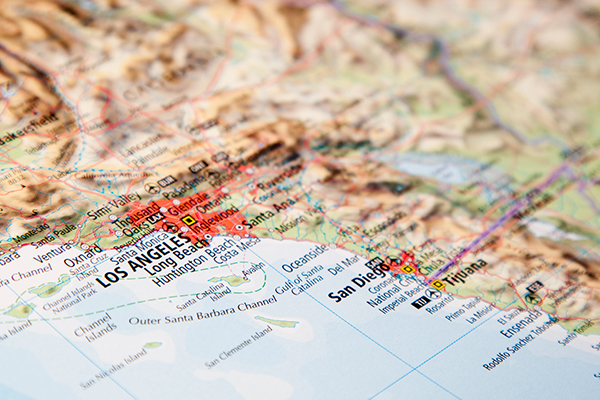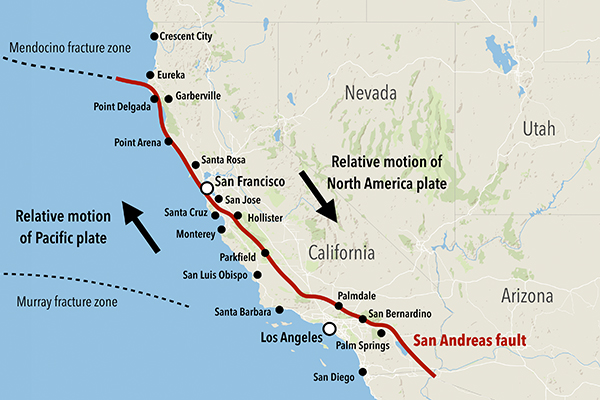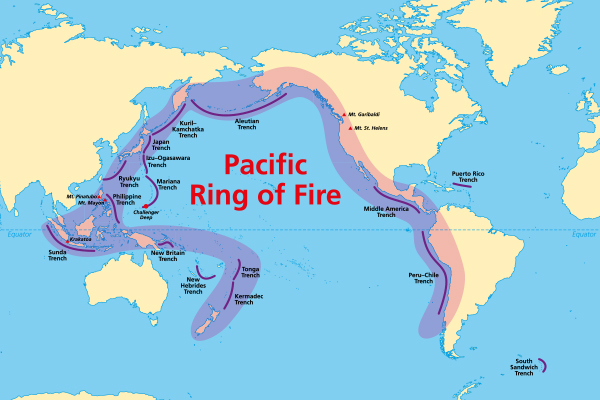Hundreds of earthquakes happen around the world every day. The American Museum of Natural History explains that “earthquakes are happening all the time, on land and in the ocean.” In fact, the USGS estimates that there are 500,000 detectable earthquakes worldwide each year. It reports that about 100,000 of them are big enough to be felt, with about 100 of them causing actual damage.
Earthquakes occur along faults, which are cracks in the Earth’s crust where the tectonic plates meet. The tectonic plates are always in motion, grinding against each other along plate boundaries. Sometimes they get stuck, and pressure builds between the plates. When too much pressure builds up, the plates suddenly break free of each other and that pressure is released, which can cause the ground to tremble or shake. We call this trembling or shaking an earthquake.
Some parts of the world experience more earthquakes than others. California is known as “Earthquake Country,” as it’s the second most seismically active state in the United States.
How Often Do Earthquakes Happen in California?
California experiences more than 100 earthquakes per day! The USGS estimates that Southern California alone experiences about 10,000 earthquakes per year, though the vast majority of them are too small to be felt by people.
The California Department of Conservation reports that CA experiences “two or three earthquakes large enough to cause moderate damage to structures (magnitude 5.5 and higher)” each year. It’s important to prepare for earthquakes ahead of time, especially if you live on or near an active fault line.
Unfortunately, some of the most populated cities in California are extremely likely to experience earthquakes. San Francisco, Los Angeles, and San Diego are all included in the “high-hazard” earthquake areas that cover large portions of the state.
The Northridge Earthquake, which struck California in 1994, caused billions in damage and killed at least 57 people. Thousands of residences suffered structural failures, with collapsed walls, fractured foundations, and damaged roofs being common sights.
How Often Do Earthquakes Occur in San Francisco?
San Francisco sits on the San Andreas fault, a very active fault. The Hayward fault and the Calaveras fault also run through the Bay Area. Earthquakes occur frequently in the area, and San Francisco Tourism Tips reports that around 5,000 or more earthquakes occur “in and around the San Francisco Bay Area” each year. The largest earthquake in San Francisco’s history was the 1906 San Francisco earthquake, which reached 7.9 on the earthquake magnitude scale.
How Often Do Earthquakes Occur in Los Angeles?
The California Earthquake Authority (CEA) reports that people in LA County feel shaking from earthquakes a couple times a year, though most of those earthquakes are mild or moderate, with little damage. The Federal Emergency Management Agency (FEMA) has placed Los Angeles in the category of “very high risk” for earthquakes. LA’s earthquake risk is so high because so many active faults run through the county, including the famous San Andreas fault.
How Often Do Earthquakes Occur in San Diego?
Since 1984, earthquake activity in San Diego County has doubled compared to the preceding 50 years. The Earthquake Country Alliance reports that most people in San Diego County live less than 15 miles from a fault, increasing their risk of earthquake damage. The Rose Canyon fault, which scientists believe can generate 6.9 magnitude earthquakes, runs beneath downtown San Diego. There have also been several major earthquakes in San Diego’s history, including the 1968 Borrego Mountain earthquake, which had a magnitude of 6.5.
Why Does California Have So Many Earthquakes?
National Geographic reports that California experiences an earthquake every three minutes. California is located along the boundary of two very active tectonic plates, the Pacific Plate and the North American Plate. These two plates are constantly moving and grinding against each other. This movement creates stress in the rocks, which can eventually be released in the form of an earthquake.
The California Geological Survey reports that there are “thousands of recognized faults in California”. The most famous fault in California is the San Andreas fault. This fault is one of the largest faults in the world, running over 800 miles from the Salton Sea to Cape Mendocino.
According to the Earthquake Country Alliance, the movement along the San Andreas fault is the “driving force of earthquakes in California.”
When is the Next Major California Earthquake?
It is impossible to predict earthquakes in advance, and so no one can say exactly when the next major California earthquake will occur.
But even though we can’t pinpoint exactly when the next major earthquake will happen, we can protect ourselves from earthquake damage by preparing now. In particular homeowners can take steps to better strengthen their home against earthquake damage.
Are Earthquakes More Frequent In Certain Areas?
While earthquakes can occur at any time, the USGS reports that “history shows [earthquakes] occur in the same general patterns year after year, principally in three large zones of the earth.”
These zones include:
- The circum-Pacific seismic belt, which runs along the rim of the Pacific Ocean. About 81% of the earth’s largest earthquakes occur here. This area is nicknamed the Pacific “Ring of Fire.”
- The Mid-Atlantic Ridge, where two tectonic plates are moving away from each other. Most of the Ridge is underwater, and far from humans.
- The Alpide earthquake belt, which runs from Java to Sumatra through the Himalayas, the Mediterranean, and into the Atlantic Ocean. About 17% of the world’s largest earthquakes occur here.
How to Protect Yourself & Your Family from Earthquakes
The best way to protect your home and your family from earthquakes is to start preparing for an earthquake well before the ground begins to shake.
Find out how much earthquake risk you face by viewing the California earthquake probability map, reading about the 7 essential earthquake safety tips, and building your own earthquake emergency kit. If you are a homeowner in California, your preparedness plan should also include finding out if your house needs an earthquake retrofit.
Remember that earthquake preparedness can save lives.
Visit our Seismic Strong Blog for tips, advice and more information about earthquakes.



